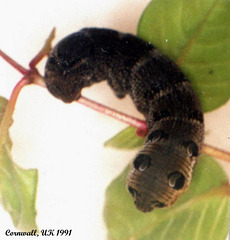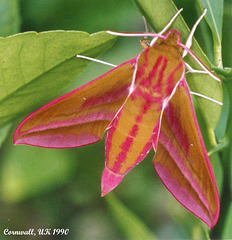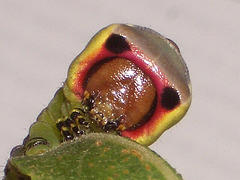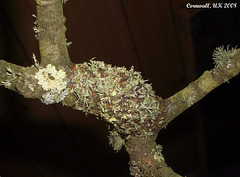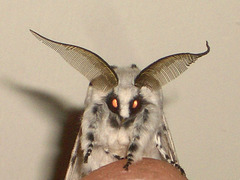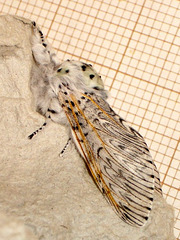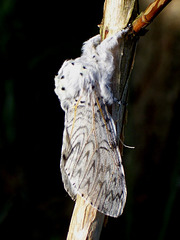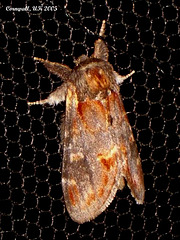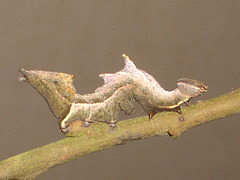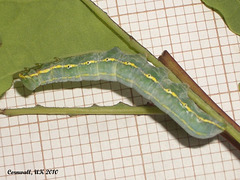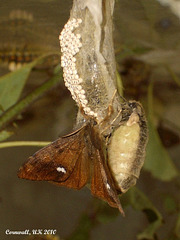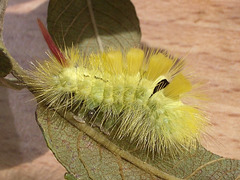
Rearing Cornwall Moths
Folder: Moths in Cornwall UK
Caterpillars shown here have been reared from eggs laid by adults collected from recording sessions around Cornwall, or from wild collected caterpillars found.
Numbers used in the titles are the UK Bradley 2000 list references.
1991 Deilephila elpenor (Elephant Hawkmoth)
| |
|
Sphingidae Macroglossinae Final Length: ~70mm
Another view of the caterpillar, with the head retracted, showing the defensive posture. If disturbed, the head is pulled back into the third segment, causing the eye-spots to swell and looking somewhat like the head of a small snake.This specimen was found feeding on a garden Fuscia.
1991 Deilephila elpenor (Elephant Hawkmoth)
| |
|
Sphingidae Macroglossinae Final Length: ~70mm
The caterpillar of this species gives the source of its common name, as the shape, colour, and motion of it is reminiscent of an Elephant including the trunk, when it is searching for new food to eat (as in this picture).
1991 Deilephila elpenor (Elephant Hawkmoth)
| |
|
|
|
Sphingidae, Macroglossinae Wingspan: 74mm.
This is one of the commonest UK Hawkmoths, and the above specimen had just emerged from the pupa, so it's colours were fresh and pristine. The colours mimic the flowers of the Rosebay Willowherb (Chamerion angustifolium), a large wild plant which grows in swathes on wild or disused ground. It is also one of the food plants for the caterpillars.
1995 Cerura vinula (Puss Moth) L
| |
|
Notodontidae, Notodontinae. Final Length ~70mm.
A widespread but generally not common species in Cornwall, where-ever Salix bushes (Sallows, & Willows) occur. The caterpillars, particularly in later instars are quite prettily coloured individuals, and have the rear pair of clasper legs modified into two stiff tubes, from which, when disturbed, thin red thread-like "whips" can be extended, supposedly to drive off parasitic wasps. They are, however, fairly ineffectual when deployed so it may be just for show, or a distraction activity to confuse potential predators.
1995 Cerura vinula (Puss Moth) L
| |
|
|
Notodontidae, Notodontinae. Final Length: ~70mm.
The UK common name of this speciesis based on the first segment, which creates a flat frame to the head proper. In smaller instars, the corners marked by the black spots in this photograph have small lobes sticking out from them, making the head of the caterpillar look like the face of a cat, hence the name "Puss Moth". In the last instar caterpillar, these lobes are replaced by the black spots on a smoother face.
1995 Cerura vinula (Puss Moth) Cocoon
| |
|
|
Notodontidae, Notodontinae.
Another notable thing of this species is the formation of the cocoon. Having found a suitable site, the caterpillar will gnaw out a hollow in the wood, whilst sticking the removed pieces into a silk covering over the top of it. Gradually, a hard shell is formed, which is the same colour as the wood on which it is made, creating a swelling in the wood surface. In this case, the cocoon was also decorated with bits of Lichen as well, creating a superb camouflage.
1995 Cerura vinula (Puss Moth)
| |
|
|
|
Notodontidae, Notodontinae. Wingspan: 80mm.
The feathery antennae and the glowing eyes makes this little insect look quite threatening.
See Album: Small Families 2
1995 Cerura vinula (Puss Moth)
| |
|
Notodontidae, Notodontinae. Wingspan: 80mm.
A widespread but generally not common species in Cornwall, where-ever Salix bushes (Sallows, & Willows) occur. This species is notable for the amazingly adapted caterpillars, and the way their cocoons are made.
1995 Cerura vinula (Puss Moth)
| |
|
Notodontidae, Notodontinae. Wingspan: 80mm.
A widespread but generally not common species in Cornwall, where-ever Salix bushes (Sallows, & Willows) occur. This species is notable for the amazingly adapted caterpillars, and the way their cocoons are made.
2000 Notodonta dromedarius (Iron Prominent)
| |
|
Notodontidae, Notodontinae. Final Length: 35mm.
A typical fairly common member of this sub-family, the caterpillar is unmistakable from its posture and general shape of the more common species. Presumably, the common UK name is based on the fact that the caterpillar and the moth appears to have "rusty" patches over them.
2000 Notodonta dromedarius (Iron Prominent)
| |
|
Notodontidae, Notodontinae. Wingspan: 42mm
One of the common "Prominents" in Cornwall seen every year at light traps.
2003 Notodonta ziczac (Pebble Prominent)
| |
|
Notodontidae, Notodontinae. Final Length: ~35mm
The English common name for the members of this family, the "Prominents" refers to the fact that the caterpillars usually have strange postures and protuberances along their length. This species even has unusual colouration for a caterpillar, but presumably results in potential predators thinking that they are not food.
2003 Notodonta ziczac (Pebble Prominent)
| |
|
|
Notodontidae, Notodontinae. Wingspan: 46mm
This pretty moth is a common resident species and is usually a good size and unusually marked. It will regularly come to light traps, often in small numbers. Like most typical Notodontid species, the caterpillars lift their hind claspers up at rest, as in the preceding photograph.
2015 Drymonia ruficornis (Lunar Marbled Brown) L
| |
|
Notodontidae, Notodontinae. Final Length: ~45mm.
Almost identical to the caterpillar of the Marbled Brown, the only way to be sure is to rear the adult insect from them. A very "normal" shaped caterpillar, with no prominent differences from many others. Both species have fainter yellow lines along the back as well.
2015 Drymonia ruficornis (Lunar Marbled Brown)
| |
|
Notodontidae, Notodontinae. Wingspan: 42mm
More widespread in Cornwall than the previous species, and occurring in greater numbers, it comes readily to light traps during April and May.
2026 Orgyia antiqua (Vapourer) L
| |
|
|
Erebidae, Lymantriinae Final Length: ~30mm.
This small Lymantrid is quite local in Cornwall, although fairly common where they occur, as eggs are laid in large batches on the cocoons. The only means of dispersal is by the fast moving caterpillars spreading out from their hatching area. The bright colours of the caterpillars indicate that the hairs are urticating, and these are even transferred to the cocoons when spun. Even moving the cocoons resut in bad irritation to skin.
2026 Orgyia antiqua (Vapourer)
| |
|
Erebidae, Lymantriinae Wingspan (Males):36mm, (Females): Wingless.
Females are sedentary, and stay on the cocoon after emergence. Flying Males can home in to the pheromones released by the Females, and will instantly mate with a free Female. Once fertilised, the Females lay rows of eggs onto the surface of the cocoon. She will be repeatedly mated (as above) until all eggs are laid, and she then expires.
2028 Calliteara pudibunda (Pale Tussock)
| |
|
Erebidae, Lymantriinae Final Length: ~45mm.
Perhaps the prettiest colour form of the caterpillar, out of a range of colours from Canary Yellow, through Pale Green, to Browns, or even Black, The large tufts of hair along the back and the often pink tail tuft add to the appeal of this species.
Jump to top
RSS feed- Latest items - Subscribe to the latest items added to this album
- ipernity © 2007-2024
- Help & Contact
|
Club news
|
About ipernity
|
History |
ipernity Club & Prices |
Guide of good conduct
Donate | Group guidelines | Privacy policy | Terms of use | Statutes | In memoria -
Facebook
Twitter

